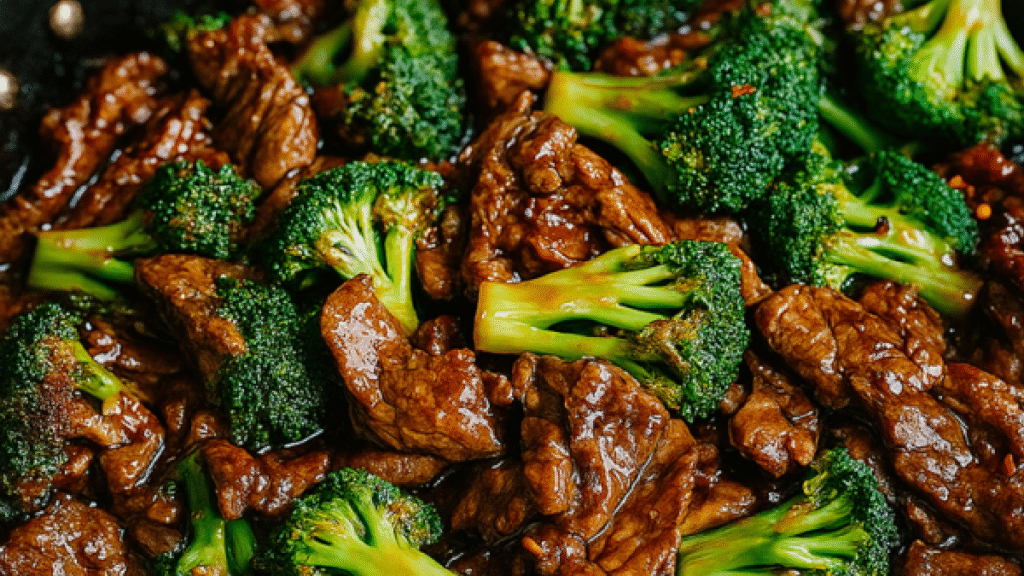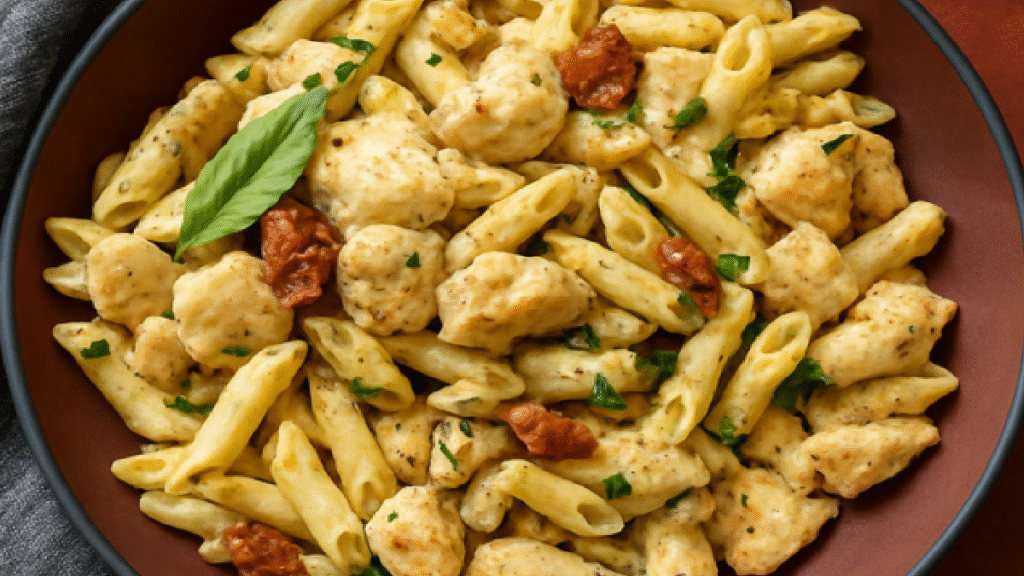Discover the simplicity of making a delicious quiche with a premade pie crust, perfect for a quick breakfast or dinner.
This versatile dish is loaded with ham, cheese, and green onions, making it a great option for any meal. The best part? You can keep the use of a premade crust a secret!
With this easy quiche guide, you’ll learn how to create a mouth-watering dish that’s sure to impress. The article will walk you through the process, providing you with a straightforward quiche recipe to try at home.
Key Takeaways
- Simple quiche making process using a premade pie crust
- Versatile filling options to suit your taste
- Perfect for breakfast or dinner
- Easy to customize with your favorite ingredients
- Great for impressing guests or family members
The Beloved French Dish: What Makes Quiche Special
With its origins in French cuisine, quiche has evolved into a popular dish enjoyed at any time of day. You can serve this recipe as an easy breakfast quiche, or enjoy it for a light lunch or dinner, making it a versatile meal option.
Origins of Quiche in French Cuisine
Quiche originated in the Lorraine region of France, where it was traditionally made with eggs, cream, and lardons (small pieces of bacon). The dish has its roots in medieval cuisine, where it was cooked in a heavy, crusty pot. Over time, quiche became a staple of French cuisine, with various regions adapting the recipe to their local ingredients.
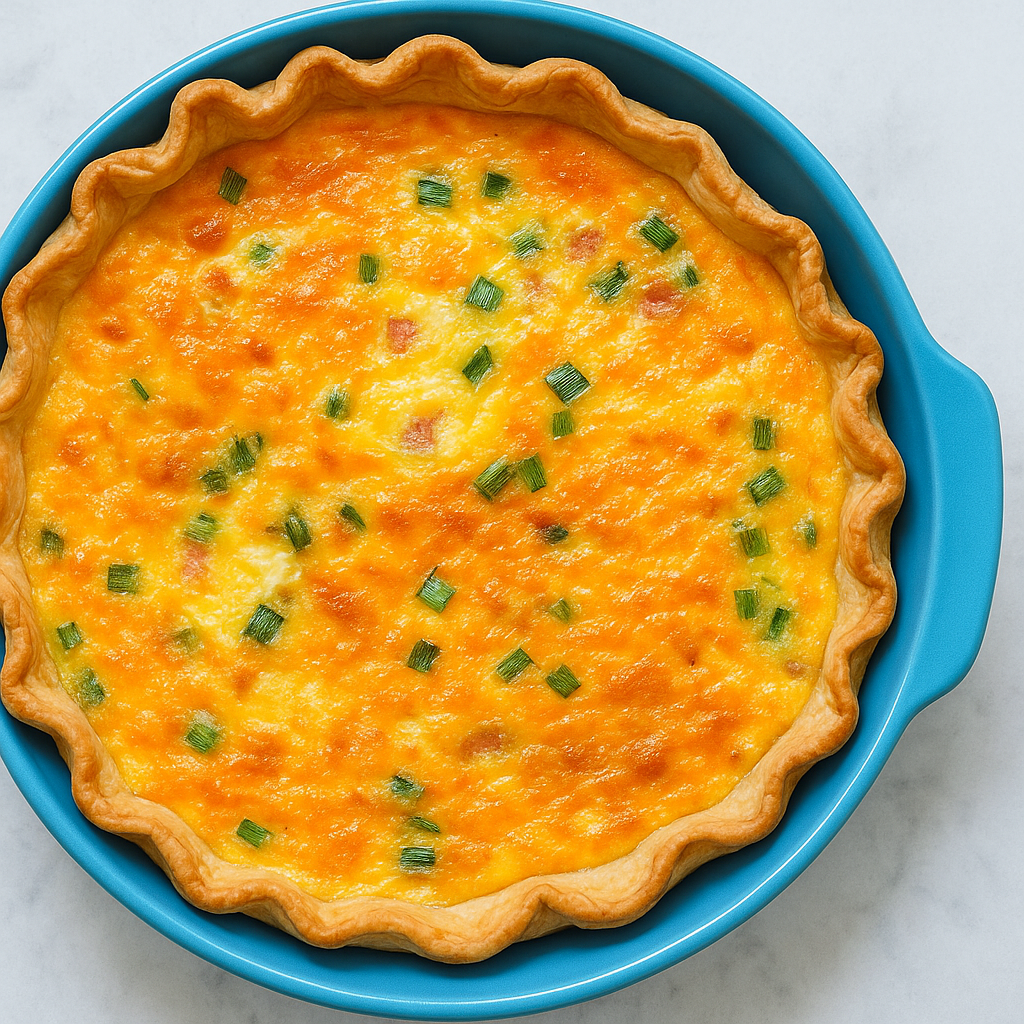
Why Quiche Remains a Popular Dish Worldwide
The enduring popularity of quiche can be attributed to its simplicity and adaptability. Quiche can be made with a wide range of ingredients, from vegetables and cheese to seafood and meats, making it a versatile dish that can cater to various tastes and dietary preferences. Its ease of preparation and the ability to serve it at any meal have contributed to its global appeal.
Today, quiche is enjoyed not only in France but around the world, with different cultures adding their own twist to the traditional recipe. Whether you’re looking for a classic quiche Lorraine or a modern variation, this beloved dish continues to delight palates everywhere.
Essential Ingredients for a Classic Quiche Recipe
The art of making quiche begins with selecting the finest and most appropriate ingredients. A classic quiche recipe relies on a harmonious balance of crust and filling, each with its own set of essential components.
The Perfect Quiche Crust Ingredients
Crafting the perfect quiche crust starts with understanding the role of different ingredients. The crust is primarily made of flour, fats, and sometimes water.
Flour Types and Their Effects
The type of flour used can significantly affect the texture of the quiche crust. All-purpose flour is commonly used due to its balanced protein content, which provides structure without making the crust too tough. For a more delicate crust, cake flour can be an option, though it’s less common for quiche.
Fats: Butter vs. Shortening
Fats are crucial for the flavor and texture of the quiche crust. Butter adds a rich flavor, while shortening can contribute to a flakier texture. Many recipes combine both for a balanced effect.
Filling Ingredients: Eggs, Cream, and More
The filling is where quiche becomes incredibly versatile, allowing for a wide range of ingredients. At its core, the filling is made of eggs, cream or milk, and various fillings such as cheese, vegetables, or meats.
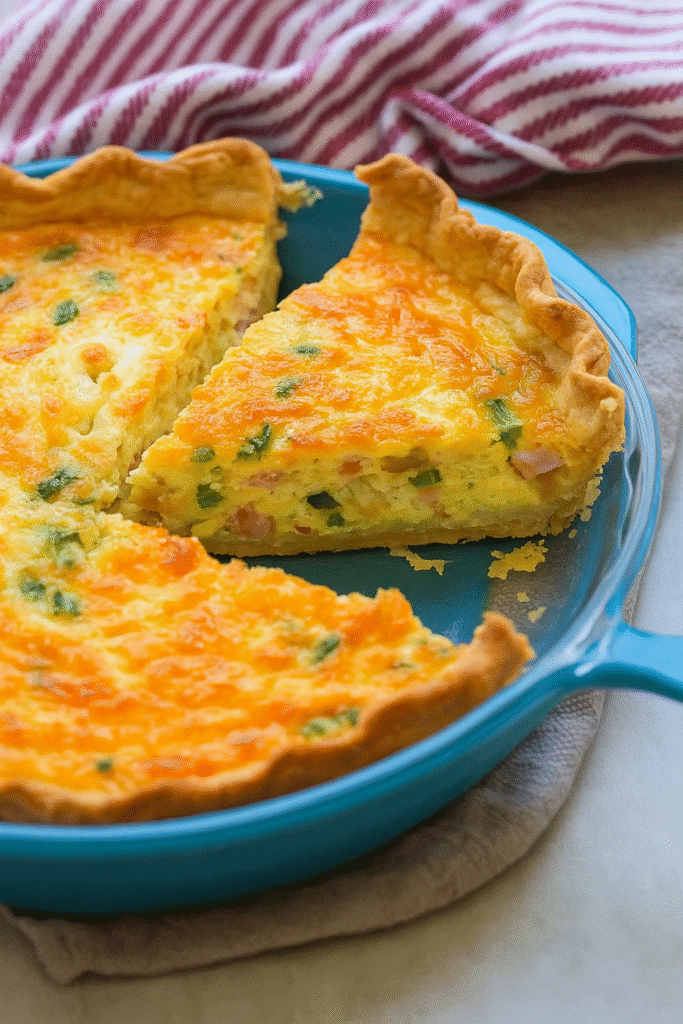
Choosing the Right Cheese
Cheese is a fundamental component of many quiche recipes, with Gruyère being traditional in Quiche Lorraine. Other cheeses like sharp white cheddar can also be used, offering a rich and melty texture. For more on creative quiche variations, you might enjoy exploring recipes like Provençal quiche.
Fresh vs. Dried Herbs
Herbs add depth and character to quiche. While fresh herbs provide a vibrant flavor, dried herbs can be more convenient and concentrated. The choice between them depends on personal preference and the specific flavors desired in the quiche.
Some key ingredients to keep in mind for a classic quiche include:
- Eggs
- Cream or milk
- Cheese (Gruyère, cheddar, etc.)
- Flour for the crust
- Fats (butter, shortening)
- Herbs (fresh or dried)
Kitchen Equipment You’ll Need
Having the right kitchen equipment is essential for making a quiche that turns out perfectly. To start, you’ll need some basic tools that are commonly found in most kitchens.
Essential Baking Tools
The essential baking tools for making quiche include a pie dish, a mixing bowl, and a whisk. A 9-inch pie dish is ideal as it provides enough space for the filling. A mixing bowl is necessary for combining the eggs, cream, and other ingredients. A whisk is used to ensure the filling is smooth and well-mixed. Investing in a good quality pie dish can make a significant difference in the outcome of your quiche.
Optional Equipment for Advanced Techniques
For those looking to refine their quiche-making skills, optional equipment such as a pastry blender or a food processor can be useful. A pastry blender helps in making a flaky crust from scratch, while a food processor can be used to mix the filling ingredients more efficiently. While not necessary, these tools can enhance your quiche-making experience and provide more consistent results.
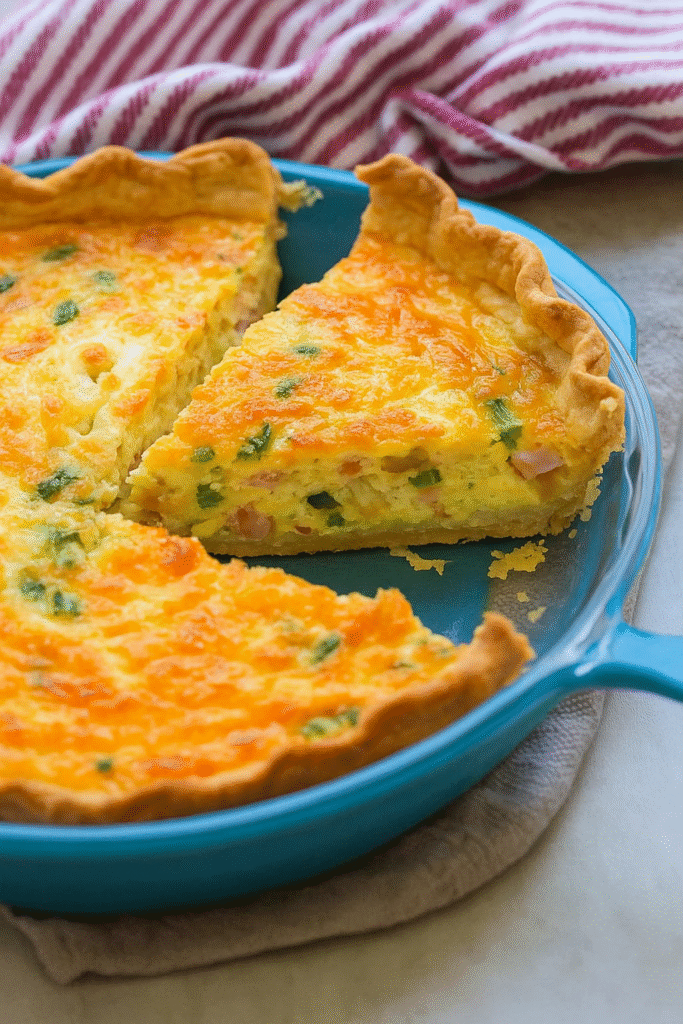
Preparing the Perfect Quiche Crust
Whether you’re a seasoned baker or a novice in the kitchen, preparing the perfect quiche crust is a skill worth mastering. The crust is the foundation of this beloved French dish, and getting it right can make all the difference in your final product.
Homemade vs. Store-Bought Crust Options
When it comes to quiche crust, you have two primary options: making it from scratch or using a store-bought version. Both have their advantages and disadvantages.
- Homemade Crust: Offers complete control over ingredients and texture. It’s a great option if you’re looking for a specific flavor or texture.
- Store-Bought Crust: Saves time and effort. It’s a convenient choice when you’re short on time or not confident in your pastry-making skills.
You can use either a homemade or store-bought pie crust for this quiche recipe, depending on your preference and the time you have available.
Step-by-Step Crust Preparation
If you decide to make your crust from scratch, follow these steps for a flaky and delicious result.
Mixing the Dough
To mix the dough, combine 2 cups of all-purpose flour, 1 teaspoon of salt, and 1/2 cup of cold unsalted butter in a bowl. Use a pastry blender or your fingertips to work the butter into the flour until the mixture resembles coarse crumbs. Gradually add ice water, stirring with a fork until the dough comes together.
Rolling and Shaping Techniques
Turn the dough out onto a lightly floured surface and gently knead a few times until it becomes smooth. Roll out the dough to a thickness of about 1/8 inch, then carefully transfer it to a 9-inch tart pan with a removable bottom. Trim the edges and prick the bottom with a fork to prevent it from bubbling during baking.
The Ultimate Quiche Recipe: Step-by-Step Instructions
To create the perfect quiche, follow these step-by-step instructions that will guide you through pre-baking the crust, preparing and adding the filling, and baking the quiche to perfection.
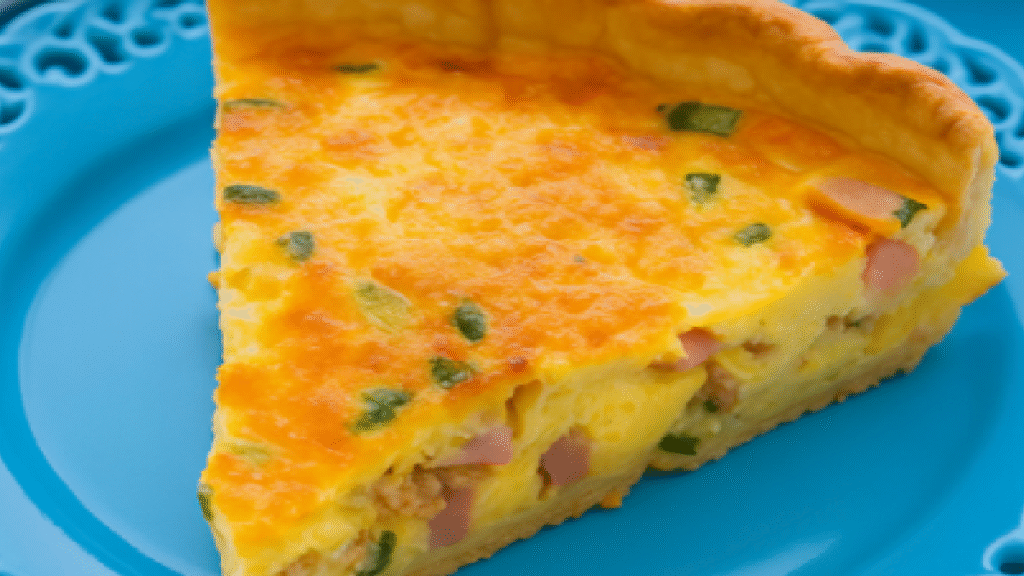
Pre-Baking the Crust
Preheating your oven to 375°F is the first step in pre-baking your quiche crust. Unroll your pie crust and gently press it into a 9″ pie plate, crimping the edges if desired to create a decorative border. This step is crucial for achieving a crispy crust.
Preparing and Adding the Filling
The filling is the heart of your quiche, and it’s where you can get creative with various ingredients. For a classic quiche, you’ll need eggs, cream, and your choice of cheese, vegetables, or meats. Beat the eggs and mix them with cream, then add your chosen fillings. Pour this mixture into the pre-baked crust, ensuring it’s evenly distributed.
Baking Times and Temperatures
Baking your quiche at the right temperature and for the correct amount of time is crucial. Bake at 375°F for about 35-40 minutes, or until the edges are golden brown and the center is set.
Visual Cues for Doneness
To check if your quiche is done, look for a golden-brown crust and a filling that is set and doesn’t jiggle when gently shaken. The edges should be slightly puffed, indicating that the quiche is cooked through.
Cooling Process
Once your quiche is baked, remove it from the oven and let it cool on a wire rack. This helps prevent the crust from becoming soggy. Let it cool for at least 10-15 minutes before serving. For more detailed quiche recipes, you can visit this page for inspiration.
Creating the Classic Quiche Lorraine
Originating from the Lorraine region, Quiche Lorraine has become synonymous with French cuisine worldwide. This classic dish is characterized by its rich filling and flaky crust, making it a staple in French bakeries and households.
Traditional Ingredients for Quiche Lorraine
The authenticity of Quiche Lorraine lies in its simplicity and the quality of its ingredients. Traditional Quiche Lorraine is made with a few key components: a pastry crust, eggs, heavy cream, and lardons (small pieces of bacon). The eggs and cream form the custard base, while the lardons add a smoky flavor. It’s essential to use high-quality ingredients, such as farm-fresh eggs and thick-cut bacon, to achieve the authentic taste.
The pastry crust is another crucial element. While some may opt for a store-bought crust, traditionalists prefer making their own pâte brisée from scratch. This involves mixing flour, butter, and water to create a dough that is then chilled and rolled out.
Authentic French Preparation Methods
Preparing Quiche Lorraine involves several steps that require attention to detail. First, pre-bake the pastry crust until it’s golden brown. Meanwhile, cook the lardons until crispy and set them aside. In a separate bowl, whisk together eggs, heavy cream, salt, and pepper to create the custard filling.
To assemble the quiche, spread the cooked lardons evenly across the pre-baked crust, followed by grated cheese if desired. Pour the custard filling over the lardons and bake until the quiche is set and the top is lightly browned. The result is a beautifully baked quiche with a creamy interior and a crispy crust, embodying the essence of French quiche tradition.
Popular French Quiche Variations to Try
The beauty of quiche lies in its adaptability, as evident in the diverse range of French quiche variations that cater to different tastes and ingredients. This beloved dish has been reimagined across various regions in France, each incorporating local flavors and ingredients to create unique quiche recipes.
Quiche Alsacienne with Onions
Quiche Alsacienne, originating from the Alsace region, is a flavorful variation that features caramelized onions, often combined with bacon or ham. The sweetness of the onions pairs perfectly with the savory elements, creating a rich and satisfying quiche. This regional quiche is a testament to the Alsatian tradition of incorporating local ingredients into their cuisine.
Provençal Quiche with Mediterranean Vegetables
In the Provence region, quiche is often filled with Mediterranean vegetables such as zucchini, bell peppers, and cherry tomatoes, reflecting the region’s emphasis on fresh, vibrant ingredients. This quiche variation is not only colorful but also bursting with the flavors of the Mediterranean, making it a perfect representation of Provençal cuisine.
Seafood Quiche from Brittany
Brittany, known for its coastal cuisine, offers a seafood quiche that showcases the region’s seafood bounty. This quiche typically includes a mix of seafood such as shrimp, mussels, and cod, combined with cream and herbs. The result is a quiche that is both hearty and refined, capturing the essence of Brittany’s maritime culture.
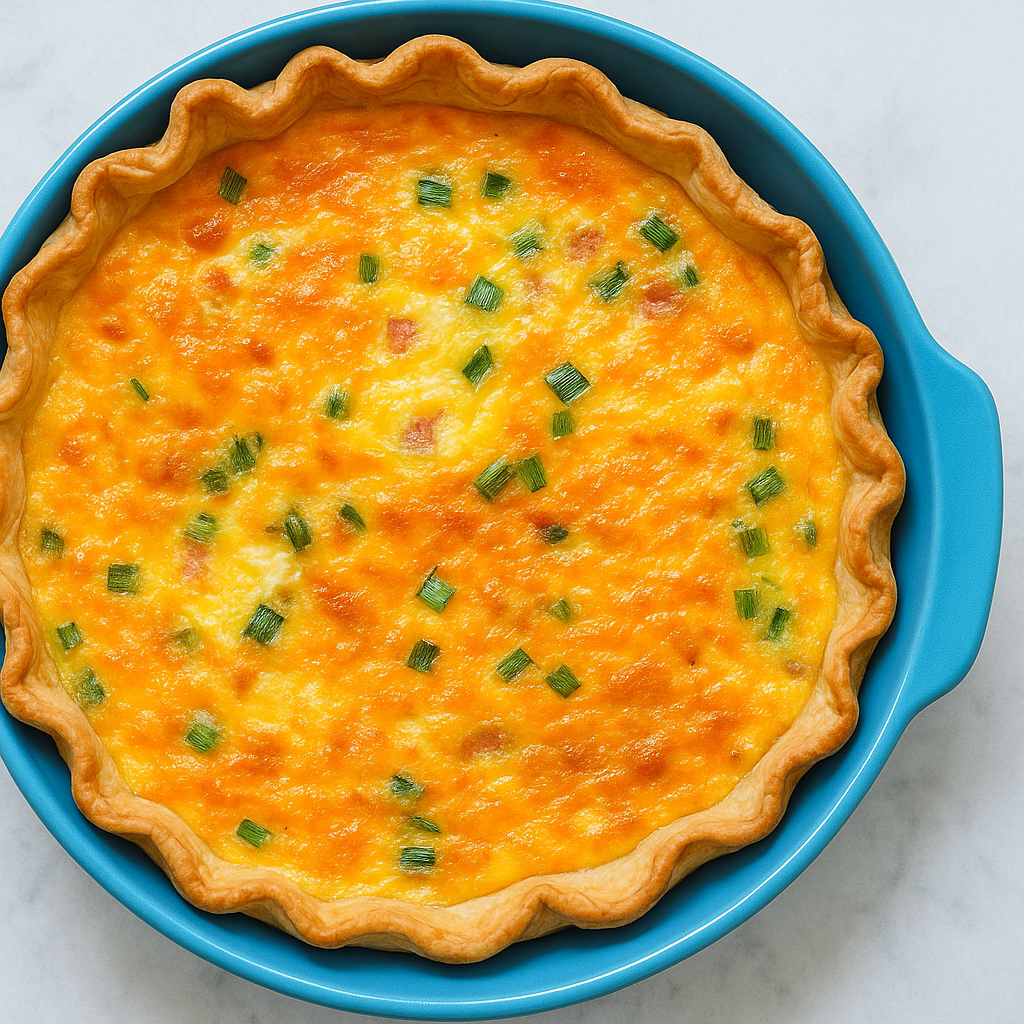
Goat Cheese and Herb Quiche from the Loire Valley
The Loire Valley is famous for its goat cheese, and its quiche variation highlights this local specialty. The quiche is filled with tangy goat cheese and a selection of fresh herbs, creating a refreshing and flavorful dish. This quiche variation is a delightful representation of the Loire Valley’s culinary traditions.
These French quiche variations demonstrate the dish’s incredible versatility and its ability to be reimagined with local ingredients and flavors. Whether you’re from Alsace, Provence, Brittany, or the Loire Valley, there’s a quiche variation that’s sure to delight your taste buds.
Tips for a Perfectly Baked Quiche Every Time
The key to a flawless quiche lies in understanding the nuances of baking and preparation. To achieve a perfectly baked quiche, one must consider several critical factors, including baking tips and techniques that ensure a delicious outcome.
Avoiding Common Baking Mistakes
One of the most common mistakes in quiche baking is overmixing the filling, which can lead to a dense and unpleasant texture. It’s crucial to mix the ingredients just until they come together, avoiding overbeating the eggs or cream. Another mistake is overbaking, which results in a dry quiche. To avoid this, keep an eye on the quiche’s edges and center, removing it from the oven when it’s just set.
As noted by culinary experts, “A perfectly baked quiche should have a tender crust and a creamy, just-set filling.” Mastering quiche baking is not just about following a recipe; it’s about understanding the intricacies of the baking process.
Professional Chef Secrets
Professional chefs often rely on specific techniques to ensure their quiches turn out perfectly. Two critical aspects are temperature control and texture management.
Temperature Management
Maintaining the right oven temperature is crucial for quiche baking. A preheated oven at the correct temperature ensures that the quiche cooks evenly. It’s also essential to avoid sudden temperature changes, which can cause the quiche to crack or cook unevenly.
Texture Control
Achieving the perfect texture involves balancing the creaminess of the filling with the flakiness of the crust. To accomplish this, chefs often use techniques like blind baking the crust and carefully managing the baking time. The result is a quiche that is both creamy and firm, with a crust that is not soggy.
By following these baking tips and understanding the importance of temperature control, you can create a quiche that is sure to impress. Whether you’re a novice or an experienced baker, mastering the art of quiche baking is a rewarding skill that elevates any meal.
Make-Ahead and Storage Instructions
The flexibility of quiche extends to its storage options, allowing you to enjoy it at a later time. Whether you’re preparing for a busy week or hosting a dinner party, knowing how to store quiche properly is essential.
Refrigeration Guidelines
Quiche can be refrigerated for up to 3 to 5 days after baking. To store, let it cool completely, then cover it tightly with plastic wrap or aluminum foil. When you’re ready to serve, reheat it in the oven at 350°F (175°C) until warmed through. It’s essential to check that the quiche is reheated to a safe internal temperature to avoid foodborne illness.
- Cool the quiche completely before refrigerating.
- Use plastic wrap or aluminum foil to cover the quiche tightly.
- Reheat in the oven at 350°F (175°C) until warmed through.
Freezing and Reheating Your Quiche
For longer storage, quiche can be frozen. Wrap the cooled quiche in plastic wrap or aluminum foil and place it in a freezer-safe bag. When you’re ready to eat it, thaw the quiche overnight in the refrigerator, then reheat it in the oven. Freezing is a great way to enjoy quiche at a later date without sacrificing flavor or texture.
- Wrap the quiche securely to prevent freezer burn.
- Thaw overnight in the refrigerator before reheating.
- Reheat in the oven until the quiche is hot and set.
By following these storage and reheating guidelines, you can enjoy your quiche at its best, whether it’s a day after baking or weeks later.
Serving Suggestions and Accompaniments
To elevate your quiche experience, consider pairing it with the right side dishes and wine. Quiche is a versatile dish that can be enjoyed at any meal, whether it’s breakfast, lunch, or dinner. The key to a well-rounded meal is balancing flavors and textures.
Perfect Side Dishes for Quiche
Serving quiche with a fresh salad or roasted vegetables is a great way to create a balanced meal. For a lighter option, a simple green salad with a light vinaigrette complements the richness of quiche. For a heartier meal, consider roasted vegetables like asparagus or Brussels sprouts, which add a nice contrast in texture. You can also pair quiche with a fruit salad for a refreshing contrast.
Wine Pairings for a French-Inspired Meal
When it comes to wine pairings, quiche can be matched with a variety of wines to enhance its flavors. For a classic Quiche Lorraine, a dry white wine like Chardonnay or Sauvignon Blanc pairs nicely. For quiches with richer fillings, such as those containing mushrooms or ham, a light red wine like Pinot Noir can be a good match. As “Wine is the perfect accompaniment to quiche, elevating the dining experience.” The key is to balance the wine’s flavor profile with the quiche’s ingredients.
For a more French-inspired meal, consider pairing your quiche with a glass of Sancerre or Chablis, both of which are crisp and refreshing white wines that complement the delicate flavors of quiche.
Nutritional Information and Dietary Adaptations
Quiche, a versatile French dish, can be adapted to various dietary needs without compromising on flavor. This adaptability makes quiche a popular choice for many. Understanding its nutritional profile is key to appreciating its value in a balanced diet.
Calorie and Nutrient Breakdown
A typical quiche can vary significantly in calorie count based on the ingredients used. For instance, a quiche Lorraine with heavy cream and bacon can be quite rich, while a vegetable quiche can be relatively lighter. On average, a slice of quiche (1/8 of a 9-inch quiche) can range from 250 to 500 calories. The nutrient breakdown includes proteins from eggs, fats from cream or milk, and various vitamins and minerals from vegetables or cheese. For a healthier option, consider using egg whites, low-fat dairy, and plenty of vegetables.
Some key nutrients found in quiche include:
- Protein: Eggs and cheese are excellent sources of protein.
- Calcium: Dairy products contribute to the calcium content.
- Vitamin D: Eggs and fortified dairy products can be good sources.
- Fiber: Adding vegetables can increase the fiber content.
Making Your Quiche Gluten-Free or Dairy-Free
For those with dietary restrictions, quiche can be easily adapted. To make a gluten-free quiche, use a gluten-free crust made from almond flour or a pre-made gluten-free crust mix. For a dairy-free quiche, substitute traditional dairy products with non-dairy alternatives like almond milk, soy milk, or coconut cream. You can also use vegan cheese alternatives. For more inspiration on healthy, adaptable recipes, check out this quinoa salad recipe that showcases versatile ingredients.
Some tips for adapting quiche to dietary needs include:
- Using gluten-free flours for the crust.
- Substituting dairy with non-dairy milk and cheese alternatives.
- Adding a variety of vegetables to increase nutrient density.
Troubleshooting Common Quiche Problems
Making quiche can sometimes be a trial-and-error process, but with a few tips, you can overcome common issues. Whether you’re a seasoned baker or a beginner, understanding how to address problems can elevate your quiche-making skills.
Fixing a Soggy Bottom Crust
A soggy bottom crust can be a disappointment. To avoid this, try pre-baking the crust before adding the filling. This step, known as blind baking, helps create a barrier against moisture. Additionally, ensure your filling ingredients aren’t too wet; drain excess moisture from vegetables and use the right balance of eggs and cream. For more on preparing quiche fillings, you might find inspiration in recipes like tarte au thon, which balance flavors and textures perfectly.
Solutions for Overcooked or Undercooked Quiche
Overcooking or undercooking quiche can result in an undesirable texture. To achieve a perfectly cooked quiche, monitor the baking time and temperature closely. Use a thermometer to ensure your oven is at the right temperature. If you notice the edges browning too quickly, cover them with foil to prevent overcooking. For an undercooked quiche, simply return it to the oven for a few more minutes. The key is to bake until the center is just set and still slightly jiggly.
The Cultural Significance of Quiche in French Cuisine
Quiche, a dish deeply rooted in French culinary tradition, has evolved into a global phenomenon. Its rich history and versatility have made it a staple in French cuisine, captivating the hearts of food enthusiasts worldwide.
Regional Variations Across France
Quiche has diverse regional interpretations across France, reflecting local ingredients and culinary traditions. From the classic Quiche Lorraine to variations like Quiche Alsacienne and Provençal quiche, each region adds its unique twist to this beloved dish.
How Quiche Became an International Favorite
The global popularity of quiche can be attributed to its adaptability and the ease with which it can be incorporated into various cuisines. As international travel and culinary exchange increased, quiche spread beyond France, becoming a favorite in many parts of the world.
This widespread appeal is a testament to quiche’s enduring charm and its ability to transcend cultural boundaries, making it a true icon of French cuisine on the global stage.
Conclusion: Mastering the Art of Quiche Making
With practice and patience, you can achieve quiche mastery and become proficient in French cooking. The art of quiche making is a skill that can be developed over time, and by following the steps outlined in this article, you’ll be well on your way to creating delicious quiches that will impress your family and friends.
Quiche making is not just about following a recipe; it’s about understanding the techniques and ingredients that make a great quiche. By experimenting with different fillings and ingredients, you can put your own twist on this classic French dish and make it your own.
As you continue to explore the world of quiche making and French cooking, you’ll discover new flavors and techniques to enhance your culinary skills. Whether you’re a beginner or an experienced cook, the art of quiche making is a rewarding and delicious pursuit that is sure to bring joy to your kitchen.
FAQ
What is quiche, and how did it originate?
Quiche is a French dish made with a pastry crust filled with eggs, cream, and various ingredients. It originated in the Lorraine region of France, where it remains a staple.
What are the essential ingredients for a classic quiche recipe?
The essential ingredients include a pastry crust, eggs, cream, cheese, and various fillings such as vegetables, meats, or seafood.
Can I use a store-bought pie crust for quiche?
Yes, you can use a store-bought pie crust, but making your own crust from scratch can result in a flakier and more flavorful quiche.
How do I prevent a soggy crust when making quiche?
To prevent a soggy crust, pre-bake the crust before adding the filling, and make sure the filling is not too wet or overcooked.
What are some popular variations of quiche?
Some popular variations include Quiche Lorraine, Quiche Alsacienne with onions, Provençal quiche with Mediterranean vegetables, seafood quiche from Brittany, and goat cheese and herb quiche from the Loire Valley.
Can quiche be made ahead and refrigerated or frozen?
Yes, quiche can be made ahead, refrigerated for up to 3 days, or frozen for up to 2 months. Reheat it in the oven or microwave before serving.
How do I reheat quiche without overcooking it?
Reheat quiche in the oven at 350°F (175°C) for 15-20 minutes, or until warmed through. You can also reheat it in the microwave, but be cautious not to overcook.
What are some suggested side dishes and wine pairings for quiche?
Suggested side dishes include salads, roasted vegetables, and bread. For wine pairings, consider a dry white wine like Sauvignon Blanc or Pinot Grigio, or a light red wine like Pinot Noir.
Can quiche be adapted to suit different dietary requirements?
Yes, quiche can be made gluten-free by using a gluten-free crust, and dairy-free by substituting cream with a non-dairy alternative.
How do I troubleshoot common quiche problems like overcooking or undercooking?
To avoid overcooking, check the quiche frequently during baking, and remove it from the oven when the edges are set and the center is still slightly jiggly. For undercooking, return the quiche to the oven for a few more minutes.
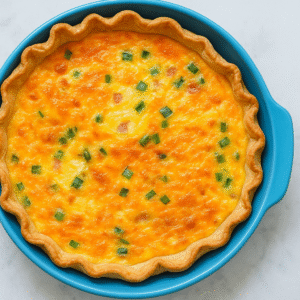
Easy Quiche Recipe
Ingredients
- 1 single pie crust unbaked
- 6 large eggs
- ¾ cup milk or cream
- ¾ teaspoon salt
- ¼ teaspoon black pepper
- 1 cup cubed cooked ham
- 1½ cups shredded cheddar cheese divided
- 3 tablespoons sliced green onions
Instructions
- Preheat oven to 375°F (190°C).
- Unroll pie crust and press into a 9-inch pie plate, crimping the top edges if desired.
- In a large bowl, whisk together eggs, milk, salt, and pepper.
- Sprinkle ham, 1 cup of cheese, and green onions into the pie crust.
- Pour the egg mixture over the fillings in the pie crust.
- Sprinkle the remaining ½ cup of cheese on top of the egg mixture.
- Bake for 35–40 minutes until the center is completely set.
- Let cool for 5–10 minutes before slicing and serving.
Notes
- Calories: 300
- Carbohydrates: 16g
- Protein: 15g
- Fat: 18g
- Saturated Fat: 7g
- Cholesterol: 190mg
- Sodium: 705mg
- Potassium: 167mg
- Sugar: 2g
- Vitamin A: 505IU
- Vitamin C: 0.6mg
- Calcium: 208mg
- Iron: 1.7mg

